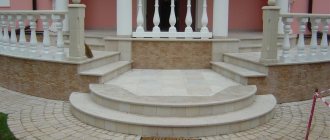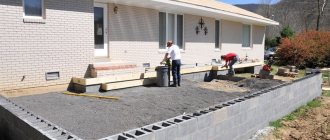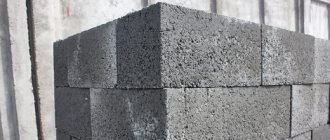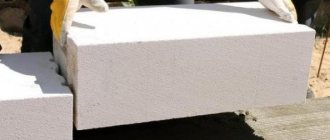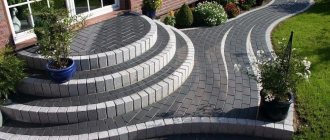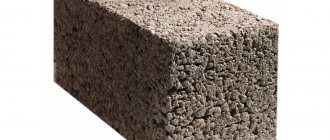The sides are mounted, supports and boards are installed for each step. There should be no gaps at the connection points to prevent water from leaking out of the concrete solution. You can additionally strengthen the sides using reinforcement rods by sticking them into the ground. Reinforcing bars are laid inside the formwork in increments of 20 cm. On the outside, the frame is covered with soil approximately 10 cm deep and compacted. After this, concreting begins.
When making calculations and drawing, you need to consider the following factors:
A pre-made plan with a diagram will save time and correctly fill the porch for a private house, since everything will be described step by step.
We recommend using ribbed reinforcement. The elements are connected to each other with soft wire or welded. To make the porch one with the house, drill small holes in the adjacent wall and insert the ends of the reinforcement there.
Basic nuances and recommendations
1. If it is very hot during work, water the concrete every day to prevent cracks.
2. When concreting, it is convenient to use a vibrating compactor. This procedure will give the structure strength, and it will be easier for you to evenly distribute the mixture.
3. To save money, some builders suggest using crushed bricks, broken glass, stones and other debris instead of sand and gravel. If you want to build a porch that will fall apart after the first winter, give it a try.
4. It is more convenient for a person to start and finish the climb with one leg, so take an odd number of steps.
5. It is better to pour concrete in clear weather; the appropriate temperature is +20 degrees.
6. The surface of the steps is arranged with a slope of 5 mm so that water flows freely from them.
7. If you decide to make a semicircular porch, it is convenient to assemble the formwork for the steps from thin galvanized plywood.
The advantage of a porch made of concrete is a wide selection of finishing materials. Thrifty craftsmen make drawings immediately after concreting using templates or lay out patterns from pebbles; this is inexpensive, but requires attention and patience. There are other options.
You can combine several options to create a porch that matches your home and is affordable. For example, wood and concrete tiles or granite and ceramic tiles. It is important to choose reliable material so that its beauty will delight you for a long time.
To ensure that the formwork can support the weight of the concrete solution, strengthen the sides of the frame. The timber is excellently suited for the role of stiffeners. Using boards that match the size and shape of the riser, the formwork is assembled. Nails act as fasteners. The bottom edge of the boards is formed at a slope to ensure a flat concrete surface.
Do-it-yourself finishing of the entrance door threshold
The gaps between the base floor and the threshold are filled with concrete mortar. After drying, it is puttied with silicone putty. The metal threshold that comes with the box does not need any decoration.
Metal threshold
In a wooden structure, cracks and chips are repaired with wood putty, the plank is primed and then, at the owner’s discretion, painted or varnished. The junction between the structure and the floor is decorated using a plinth.
For a concrete structure, painting, tiles or linoleum are used as finishing. The joint can also be hidden using a wooden, plastic or metal baseboard.
Making concrete steps
Calculations
The progress of construction of the structure depends on the size of your future concrete steps. For structures of this type, there are specially prescribed SNiP standards, according to which the flight of stairs must be reliable, durable and easy to use.
To make the correct calculation of concrete steps with your own hands, pay attention to a number of rules:
After a detailed plan with calculation of all parameters has been drawn up, you can proceed to the construction of concrete steps to the house.
Tools and building materials
If you are planning to purchase ready-mixed concrete, you need to know its volume. To prepare the solution yourself, you must proceed from the mixture consumption parameters for preparing 1 cubic meter of concrete.
You will need:
- cement – 340 kg;
- sand – 1.02 m3;
- crushed stone - 0.86 m3.
Note. To strengthen the porch structure, use reinforcement to create steps.
Materials for making concrete steps:
- Sheets of plywood and a board 2 cm thick and 20 cm wide, to form the formwork.
- Bars 40 x 40 mm for installing stiffeners.
- Nails for fixing boards.
- Metal reinforcement to strengthen the frame 6.5 - 1 2 mm.
- Waterproofing material.
- Concrete mortar or components for its preparation.
- Decoration Materials.
Tools:
- Vibrating machine to increase the density of concrete.
- Shovel and bayonet shovels.
- Concrete mixer.
- Electric saw.
- Putty knife.
- Construction tape and level.
Construction site preparation
If the construction of the porch and the simultaneous installation of concrete steps occurs at the initial stage of building a house, then preparing the site will not take much time. It is enough to clear the area of dirt and debris.
If it is necessary to replace an obsolete structure without a foundation with a new one, you must adhere to the following procedure:
- Preparing a hole for the base of the porch. The depth of the pit should be 20 - 30 degrees deeper than the freezing point of the soil. These indicators differ in different territories. The minimum depth for small steps should be half a meter. The sides of the pit for the foundation should be 25 cm higher than the dimensions of the site for building the porch.
- Preparing a recess at the base of the building for mutual reinforcement of concrete steps with reinforcement.
- Forming a “pillow” of sand and gravel at the bottom of the pit under the foundation. Sand is poured in a layer of 15 cm and moistened. Then fill the gravel with a layer of 20 cm and compact it. At the end, a ten-centimeter layer of sand is again formed. All layers are moistened abundantly with water. Such a cushion will provide reliable protection of the steps from the destructive effects of groundwater.
- Laying roofing felt for waterproofing the structure.
- Formation of a reinforcing mesh with a cell size of 10 x 10 cm.
- Filling the site with concrete mortar. Upon completion of the coating, the solution must be pierced with a metal rod to release air bubbles.
Note. In order for the foundation under the porch with steps to become stronger, you need to wait about a week.
Formwork equipment
After completing the work with the sand and gravel cushion, you can begin creating the formwork for the concrete steps. It is important to remember that the frame must be strong enough and reliable, taking into account the fact that it must withstand the weight of the concrete solution. The boundaries of the frame must correspond to the dimensions of the planned steps. To create formwork, boards or plywood are used.
The sequence of stages for creating formwork is as follows:
To ensure that the formwork can support the weight of the concrete solution, strengthen the sides of the frame. The timber is excellently suited for the role of stiffeners. Using boards that match the size and shape of the riser, the formwork is assembled. Nails act as fasteners. The bottom edge of the boards is formed at a slope to ensure a flat concrete surface.
The formwork for making concrete steps is created near the base of the house at a distance of 1 cm. Spacers are used to secure the structure, and stakes are placed to prevent it from moving. Fastening elements are immersed into the ground at least 25 cm with an installation step of 45 - 50 cm. The gaps must be covered with earth and thoroughly compacted.
Note. Plywood formwork is formed at a level of 30 cm above the height of the flight of stairs.
Before you start pouring concrete into the prepared foundation pit, you need to cover it with a vapor barrier material, which is roofing felt, after which a sealant is applied. The formwork is treated with a lubricant with a special composition to prevent concrete from sticking to boards and plywood.
Reinforcing concrete steps will help ensure the strength of the structure and extend its life. Metal rods are cut to specific sizes and fastened with wire. The length of the rods should not exceed the width of the steps, but on the contrary, be 4–5 cm shorter. The step for installing the reinforcement is 15 cm. In order to save concrete consumption, stones and crushed bricks are used, which are laid between the reinforcement.
To make the process of constructing a porch at your house faster, use the service of ordering a concrete mixer. The concrete solution must be poured from the bottom step. A very important point is the need to use the solution immediately after preparation. This is done in order to preserve its original properties. Each subsequent poured layer of concrete must be compacted to allow air bubbles to escape. Otherwise, the concrete structure will begin to quickly collapse.
Bricks and stones that protrude above the surface are pushed inside using a shovel. The quality of the concrete pouring work will be checked using a building level. The next layer of concrete is poured only after the previous layer has completely hardened.
Upon completion of the work, the formwork is left for a week until the structure completely hardens. If the work process takes place in the summer heat, the concrete solution must be moistened with water to avoid the formation of cracks. Use a hammer to remove the formwork. To do this, gently tapping and detaching the plywood and boards. If necessary, concrete porch steps can be sanded.
Firstly, to make steps for a concrete porch you need a special concrete mixture. You can make it yourself using:
Threshold functions
First of all, it is an integral part of any entrance door. The product performs several important functions: it provides protection from dust, dirt and drafts, since the threshold provides a rebate for the lower part of the door leaf.
The threshold also affects sound insulation, especially if, together with the rest of the vestibule, it is covered with a sealant.
The presence of a threshold means more reliable protection against forceful break-ins, due to the tight fit of the door leaf to the frame, and hence the reduction of the gap between them. This will prevent an intruder from sliding a crowbar under the door to pry it up or towards himself.
Foundation construction
First of all, it is necessary to mark the contour of the future concrete porch. According to this marking, you should dig the soil to a depth of 40 cm. Fill the resulting hole with sand and crushed stone mixture. The pillow should be compacted, the thickness of the layer should be from 15 to 20 cm. Next, you need to lay a layer of waterproofing.
Make several channels in the wall of the house, into which rods of reinforcing material should then be inserted. Next, hammer in the vertical rods. They should rise above the ground by about 0.2 m. The solution is mixed as follows: sand, gravel and cement are mixed, the ratio is 3:3:1. The resulting mixture is poured into the prepared structure. The foundation of our porch must dry completely; during this period it must be protected from mechanical influences.
Manufacturing of formwork
You should know that the formwork you make must match the configuration of the future porch. To begin, prepare the shapes of the elements that will serve as the edging of the structure. Mark the steps on the surfaces of the plywood panels. Cut the shields using these markings as a guide.
Next, you will need to ensure the rigidity of the structure of the future concrete porch by fastening the side panels with jumpers. The formwork assembly process is completed by fixing it to the soil surface with metal rods.
All leaks between the formwork parts must be eliminated. Mastic is used to treat the inner surface of the formwork. This will help you disassemble the structure faster after the concrete has hardened. Next, we will look at how to pour a concrete porch.
DIY porch steps made of concrete
Concrete steps for a porch are quite easy to make yourself. The reinforcement frame is the key to the strength of the concrete porch. This design will serve you for many years. Reinforcement of porch steps is carried out in stages.
The reinforcing bars must be cut according to the dimensions of the future concrete porch. To strengthen our structure, it is necessary to bind reinforcing materials with annealed wire.
The empty space is filled with stones or other construction waste.
This will help reduce the consumption of concrete mixture. Prepare the concrete mixture according to the instructions and begin pouring it into the installed formwork. The lower tier is poured first.
Using an internal vibrator, it is necessary to compact the poured concrete mass. This will help eliminate possible air inclusions.
Using a building level, level the surface to be poured. Hardening of the concrete mass in the formwork usually takes place within two weeks.
The surface of the concrete porch must be moistened with water so that the top layer of concrete does not dry out. You can also protect the structure from evaporation by covering it with polyethylene.
After two weeks, disassemble the formwork.
Before you begin building the porch, you will first need to prepare the site for construction. If there is an old porch, it must be dismantled. After this, the site is cleared of debris. There should be no vegetation within the area prepared for construction.
What factors should be taken into account when building a structure?
In the case of adding a structure to a finished structure, it is necessary to make a base, which is subsequently connected to the foundation of the dwelling using reinforcement. Let's consider what factors should be taken into account before starting construction:
Porch elements
- height. Determined by the distance from the top soil line to the bottom threshold line;
- width. Its calculation is made taking into account individual factors, such as: the number of residents and the need to transport furniture with large dimensions;
- height of steps. This indicator can vary from 12 to 20 cm. It depends on the height of the specific structure and the final number of steps;
- width of steps. The standard size suitable for comfortable movement of a person is 25 cm.
Note! To organize a free passage for 1 person, a width of 80 cm is sufficient. In turn, for two people the passage needs to be widened to 1 m.
You will also need to make a concrete porch with steps 5 cm below the threshold line. This is necessary so that the door does not touch the surface of the porch when opening. And finally, when building a tall building, it is necessary to provide the porch with railings, the function of which is to ensure safety.
You might be interested in this: We build a utility block at the dacha with our own hands
Formwork assembly algorithm
The frame must follow the shape of the future structure. It must be durable and reliable. To assemble the formwork you will need to prepare plywood and boards. You can also use metal sheets and bricks.
What dimensions should the boards have? The width of the boards for assembling the frame is 20 cm, and the thickness is at least 2 cm. First, you need to install the sides, after which the supports are installed. Next, the steps are assembled.
Methods of fastening formwork and tying reinforcement
Assembly of formwork and reinforcement frame
Fiberglass reinforcement
The next step is to lay reinforcement into the internal space of the formwork. The optimal pitch for the rods is 20 cm. The last stage of assembling the formwork involves filling the frame with soil (from the outside), which is subsequently compacted.
6. The mixture is prepared in a concrete mixer according to the recipe suggested above. You should start from the bottom step. The protruding coarse aggregate must be drowned in the solution using available means.
Threshold selection criteria
If the strip comes with the door frame, then you don’t have to select a design - it is simply installed when installing the frame. If the front door kit does not provide it, then you need to independently select the material and its design. Installation is carried out after installing the box.
When choosing a design type, consider the following parameters:
- tightness of the canvas to the threshold;
- height of the structure;
- the material from which it will be made.
Making steps
A reliable and durable porch can only be built if quality ingredients are used and technology is followed. There are two options: use a ready-made solution or make it yourself. The purchase will reduce the period of work, but will significantly increase the cost of the object. Depending on the brand of cement and requirements, several formulations can be considered. Composition (option): cement (M400) - 100 kg, crushed stone (1-2 cm in size) - 400 kg, sand (sifted) - 200 kg, water, additives.
At a private dacha, the dimensions and type are chosen in accordance with the taste and requirements of the owners. But in order to fill a structure that will be comfortable and safe to move around, it is recommended to maintain the following parameters:
- width: not less than 0.9 m;
- step depth: from 25 cm;
- angle of inclination of the structure: up to 45 degrees;
- step height: from 15 to 20 cm.
The main thing is to make a reliable foundation, since the porch will be massive, and to install the formwork correctly. You will need the following tools and devices: a concrete mixer, a vibrator, a level, a rule, a tape measure, a shovel and a spatula, as well as roofing felt, reinforcement, material and fasteners for installing the formwork.
Step-by-step instructions for making reinforced monolithic stairs:
1. The necessary measurements are taken and a drawing of the object is prepared.
2. Based on the diagram, the amount of material is calculated and the area is cleared.
3. The foundation is being poured. To do this, a pit about 0.6 m deep is dug, and formwork made of boards is installed around the perimeter. A cushion is created (sand is poured to a height of 15 cm, then 20 cm of crushed stone, followed by another 10 cm of sand), each layer of which is carefully compacted and spilled with water. After this, all that remains is to make waterproofing, for example, using roofing felt, and fill the base. It will be possible to continue work in a few days, after gaining strength.
4. Formwork is formed from plywood or boards according to the existing drawing. Its height should be 20 cm higher than the size of the future porch. The inside of the plywood is treated with a lubricant, such as machine oil, to prevent the solution from sticking. To prevent the formwork from being torn apart, spacers are placed on the outside. Be sure to lay roofing material on the bottom and apply a layer of sealant to it. In order to decorate the rounded elements, sheets of metal or plastic are used.
5. A frame of reinforcement is laid (rods with a diameter of 12 cm are taken and tied at intervals of 100 or 150 mm). It should not reach the edge of the steps by approximately 50 mm. The rods themselves should be installed on supports, the role of which can be played by pieces of brick. This must be done so that the frame is in the body of the concrete. If necessary, embedded parts are placed for the construction of railings or a protective canopy over the porch.
Important! To save material, you can throw broken bricks, stone, or pieces of concrete into the body of the staircase.
6. The mixture is prepared in a concrete mixer according to the recipe suggested above. You should start from the bottom step. The protruding coarse aggregate must be drowned in the solution using available means.
7. To eliminate air bubbles present in the poured composition, an internal concrete vibrator is used. This tool is necessary if you want to build a durable and strong structure.
8. The steps are leveled using the rule. The treads are formed at a slight angle so that trapped water can drain from them. The evenness of the surface of all elements is controlled by a level; it is important when performing further finishing.
9. Concreting is completed. The finished structure is covered with polyethylene, and after a week the formwork is dismantled. The porch will gain full strength only after 28 days. Until then, it is not recommended to apply heavy loads to it.
If you wish, you can also fill the set steps with your own hands. To do this, you need to assemble a mold into which the composition is poured. Then it is processed with a vibrator, the surface is leveled. The product is left to gain strength.
Concrete itself does not look very presentable, and it is also cold. To add attractiveness and additional protection to the structure from external influences, cladding is performed.
Finishing the steps
Depending on the exterior of the dacha itself, the design of the surrounding space, as well as the financial capabilities of the owners, various decoration options are used.
1. Pebbles or fragments of tiles. They create patterns by slightly drowning them in still damp concrete.
2. Natural or artificial stone. You can create a real architectural masterpiece.
3. Tile materials: clinker, porcelain stoneware, tiles, rubber and polymer sand coating. The tiles have excellent performance characteristics and can significantly transform the appearance of the structure.
4. WPC. Resistant to various influences and attractive in appearance, slats made of wood-polymer composite are excellent for outdoor use.
5. Tree. To finish steps located in the open air, wood treated with special protective compounds is used.
6. Mosaic. With the help of decorative coatings, interesting design structures are created.
7. Coating. Treat with a primer and paint with suitable paints.
Metal racks are installed on concrete steps using flanges or other fasteners; forged or welded gratings made of metal rods can be used as filling. Such products can be ordered ready-made in workshops, since working with metal yourself is quite difficult. Metal handrails are welded onto the racks, which are covered with wood or plastic overlays.
Using a guillotine type sill
It is also called automatic lifting threshold. This design is installed at the bottom of the door. The insertion is carried out to a depth of 20 cm.
The threshold is made of aluminum with a seal made of rubber or rubberized material and a spring.
Guillotine type threshold
On the side of the hinge post, a strip with a button is cut into the door. When closing, the button is pressed, the threshold spring is activated, and the seal falls down to the floor covering.
The service life of the structure is up to 25 years.
Such a system is easily repaired, and damaged parts can be replaced.
Installing railings on a concrete porch
For the classic fencing of a concrete porch, forged metal railings are used; they will provide reliable support and safety when moving along the stairs. Railings must be installed on a high porch, but on a small porch they will be quite appropriate.
The standard height for adults is 90 cm, and additional children's handrails can be added at a height of 40 cm. The width of the handrail is about 7 cm - this is most comfortable for the human palm.
Metal racks are installed on concrete steps using flanges or other fasteners; forged or welded gratings made of metal rods can be used as filling. Such products can be ordered ready-made in workshops, since working with metal yourself is quite difficult. Metal handrails are welded onto the racks, which are covered with wood or plastic overlays.
First, the sides are created, supports and boards are mounted for each future step. The boards should be connected so that no gaps form between them. Otherwise, water will leak out of the concrete mixture. To better strengthen the sides, you can use metal rods. To do this, they are inserted into the soil.
Threshold selection
Installing a threshold most often means replacing it - it is extremely rare that it is missing from the very beginning. The remains of the old threshold are completely removed and the surface is cleaned. If, after all, there was no threshold under the door leaf before, then you just need to thoroughly clean the floor surface under the door.
Before you begin installation, you need to decide on the material.
There are several types of thresholds that can be made from:
- wood - it is advisable to select a threshold from a single piece of wood (ash or oak) without a layer of veneer or laminate - it has much greater strength and resistance to mechanical damage;
- plastic is a material that is quite affordable and also has good strength;
Must be resistant to sunlight.
- stone - more often used for balcony doors, and in some rooms for entrance doors.
Formwork assembly
After digging the hole, you can move on to the formwork. It must be made so that it can withstand the weight of concrete. The frame should follow the shape of the future extension.
The formwork itself is assembled from boards. They should have good strength and not be too dry. Otherwise, the weight of the concrete will simply crush them, and cracks will appear on them. The optimal board width is 0.2 m and thickness is 20 mm.
First, the sides are created, supports and boards are mounted for each future step. The boards should be connected so that no gaps form between them. Otherwise, water will leak out of the concrete mixture. To better strengthen the sides, you can use metal rods. To do this, they are inserted into the soil.
Inside the formwork, the rods are installed at a distance of 20 cm from each other. From the outside of the frame, about 10 cm should be covered with soil, and then thoroughly compacted.
The advantage of a porch made of concrete is a wide selection of finishing materials. Thrifty craftsmen make drawings immediately after concreting using templates or lay out patterns from pebbles; this is inexpensive, but requires attention and patience. There are other options.
How to prepare concrete
One cubic meter of M-200 concrete mix requires about 330 kg of cement of the required marking, about 1250 kg of crushed stone, 600 kg of sand and almost two hundred liters of water. The characteristics of the resulting solution can be improved with special additives. The ingredients are kept in a certain proportion: one part cement, two – sifted sand, three – gravel or crushed stone.
To fill the porch with concrete, the solution is prepared in a concrete mixer. Cement of a suitable brand and the remaining ingredients are placed there. Water is pouring in. It is possible to mix the solution manually, but it is a labor-intensive procedure.
Concrete should have a doughy consistency - not too liquid, not too dry. In the pit it is distributed with a shovel and compacted. When the layer has completely hardened, the formwork is installed and the next stage of construction begins.
The prepared concrete mixture is produced immediately. Within half an hour it begins to harden, so you can’t wait to fill it.
Basic nuances and recommendations
1. If it is very hot during work, water the concrete every day to prevent cracks.
2. When concreting, it is convenient to use a vibrating compactor. This procedure will give the structure strength, and it will be easier for you to evenly distribute the mixture.
3. To save money, some builders suggest using crushed bricks, broken glass, stones and other debris instead of sand and gravel. If you want to build a porch that will fall apart after the first winter, give it a try.
4. It is more convenient for a person to start and finish the climb with one leg, so take an odd number of steps.
5. It is better to pour concrete in clear weather; the appropriate temperature is +20 degrees.
6. The surface of the steps is arranged with a slope of 5 mm so that water flows freely from them.
7. If you decide to make a semicircular porch, it is convenient to assemble the formwork for the steps from thin galvanized plywood.
The advantage of a porch made of concrete is a wide selection of finishing materials. Thrifty craftsmen make drawings immediately after concreting using templates or lay out patterns from pebbles; this is inexpensive, but requires attention and patience. There are other options.
You can combine several options to create a porch that matches your home and is affordable. For example, wood and concrete tiles or granite and ceramic tiles. It is important to choose reliable material so that its beauty will delight you for a long time.
To build concrete steps with your own hands, you will need to stock up on the following materials:
Precautionary measures
To ensure that cement does not crack or crumble, it is necessary to take a number of measures that will significantly reduce this likelihood.
Firstly, when preparing the mixture, it is recommended to add plasticizers and other special additives that will ensure uniformity, increase strength characteristics and help repel moisture.
Secondly, premature operation of the structure is not recommended. Experts say that cement mortar needs at least 4 weeks to gain maximum strength.
Finishing work
The finishing of concrete steps begins a month after the formwork is removed. During this time, the solution gains standard power. There may be several design options:
- The simplest solution is to cover the porch with paint intended for exterior use.
- The steps on which a pattern of pebbles is laid out look elegant (this work is done with your own hands at the stage of pouring concrete).
- The most common option is the use of clinker tiles or porcelain stoneware.
It is important that the chosen design of the porch steps is combined with the overall decoration of the building. We hope that the material presented will help you build a reliable porch that will last for a long period. The proposed video will once again describe in detail all stages of the work.
- Formwork for concrete stairs
- Porch for a private house
- Installation of attic stairs with video
- Stairs for a summer house and a private house with photos
Discuss the article on the forum
Types of monolithic stairs
According to the manufacturing method, stairs are divided into those manufactured in a factory and those erected from monolithic concrete at the installation site.
The construction industry offers many types of staircase structures, but their use is only possible in new construction. The price of the products is high, transportation and installation are possible only with the use of special technical means. These are the main reasons for deciding to make your own stairs in small individual houses.
Depending on the location of installation, stairs are divided into internal and external.
According to the type of construction, concrete monolithic stairs can be marching or spiral - these are the main options:
- The most affordable solution for self-development is considered to be staircases with one, two or more flights in a corner or straight design. Reinforcement of such structures is carried out with emphasis on the load-bearing elements of the building.
- Spiral staircases in houses are usually used to save space. Reinforcing non-standard rounded shapes of spiral staircases is quite difficult to do independently and has specific nuances. Professional design with accurate calculation of expected loads for screw structures is mandatory.


